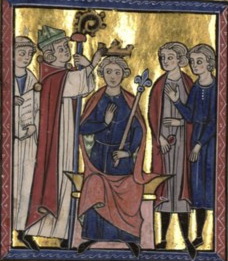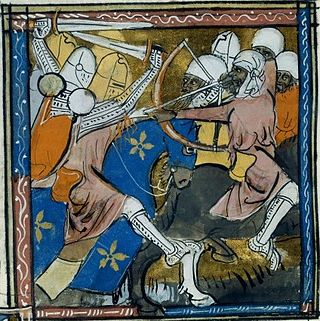Prince of Galilee
Baldwin's baron


Baldwin II of Jerusalem gave the County of Edessa to Joscelin in August or September 1119. [7] [8] Before 15 January 1120, the king granted Joscelin's former principality to William, [9] [10] [2] who thus seized one of the largest fiefs in the kingdom. [4] William was one of the four or five secular lords to attend the Council of Nablus on 16 January 1120. [11] The council confirmed the right of the clergy to control the collection of the tithes and ordered the persecution of sexual misdemeneanours. [12] [13] William donated estates in Lajjun and near Tiberias to the hospital of the Abbey of St. Mary of the Valley of Jehosaphat on 1 February 1121. [14]
Balak ibn Bahram, the Artuqid ruler of Suruç and Mardin, captured Baldwin II on 18 April 1123. [15] The Latin Patriarch of Jerusalem, Warmund of Picquigny, convoked an assembly which elected Eustace Grenier constable and bailiff to administer the kingdom, but Grenier died on 15 May or June. [16] [17] The council again assembled and appointed William to both offices. [18] Meanwhile, a Venetian fleet had landed at the Holy Land, carrying 15,000 soldiers. [19] The patriarch, William and Pagan, the chancellor of Jerusalem, concluded a treaty with the Doge of Venice, Domenico Michiel on behalf of the king. [18] [17] In accordance with Baldwin's previous promises to the Venetians, the treaty—the so-called Pactum Warmundi —granted privileges to them in both the Kingdom of Jerusalem and the Principality of Antioch in exchange for their assistance to besiege either Tyre or Ascalon. [17] [20] The barons of the realm could not decide which town should be attacked, thus their debate was settled by lot in favor of Tyre. [21]
The crusaders and the Venetians laid siege to Tyre on 16 February 1124. [21] Patriarch Warmund was acknowledged as the supreme commander of the army. [22] The defenders of the town urged Toghtekin, Atabeg of Damascus, to attack the crusaders, but he only marched as far as Banyas. [23] The patriarch appointed William and Pons, Count of Tripoli, to launch a military expedition against Toghtekin, but he avoided any engagements and returned to Damascus. [23] [24] The crusaders captured Tyre on 7 or 8 July. [21]
Baldwin II won his freedom in late August 1124, but he returned to Jerusalem only on 3 April 1125. [24] [25] He had not fathered a son and decided to give her eldest daughter, Melisende, in marriage to an influential European ruler. [26] After consulting with his barons, he chose Fulk V of Anjou. [27] He appointed William and Guy I Brisebarre to lead an embassy to Anjou and to start negotiations with Fulk. [26] [28] William was also authorized to pledge that Fulk could marry Melisende in fifty days after he came to the Holy Land and the marriage would secure his right to succeed Baldwin on the throne. [26]
The embassy departed in the autumn of 1127. [26] [20] Fulk accepted the offer and took the Cross in token of his decision to go to the Holy Land at Le Mans on 31 May 1128. [26] William and Brisbarre accompanied Fulk from France to the Kingdom of Jerusalem in the spring of 1129. [29] They landed at Acre in May. [29] Fulk married Melisende before 2 June. [30] In the same year, William donated the village of St Job (at present-day Dayr Ayyub) to the Abbey of St. Mary of the Valley of Jehosaphat, but secured the right of his nephew, William (who had become a monk) to the revenues from the leasing out of the estate. [31]
Fulk's supporter
Baldwin II died on 21 August 1131. [32] In accordance with his last will, Fulk and Melisende were jointly crowned on 14 September, but Fulk wanted to secure the government for himself and to reduce his wife to background. [33] [34] [35] He replaced the castellans of the royal castles with his own retainers from Anjou and marginalized Baldwin II's most barons. [36] In contrast with them, William retained the office of constable during Fulk's reign. [28] He witnessed Fulk's three authentic charters as the first of the secular barons. [37] The king confirmed Willim's donation to the canons of the Church of the Holy Sepulchre in 1132. [38] William accompanied Fulk during his unsuccessful campaign against Imad ad-Din Zengi, Atabeg of Mosul, who had laid siege to Montferrand (at present-day Baarin in Syria) in July 1137. [37] [39]
Most historians agree that William died between September 1143 and April or May 1144. [28] They base their view on a memorandum that Guy, Abbot of St. Mary of the Valley of Jehosaphat, compiled in the spring of 1146. [28] The abbot complained that Robert I, Archbishop of Nazareth, had cunningly installed his chaplain in the abbey's church at Lajjun after the news of Pope Innocent II's death reached the Holy Land (most probably in the spring of 1144). [28] The archbishop also instructed his chaplain to say Mass for William's soul. [28] [40] Mayer emphasizes that the memorandum does not prove that William was actually dead, because the document does not refer to his death and a Mass could also be said for the benefit of a living person. [41]
William II
According to a widespread scholarly theory, two rulers of Galilee were named William. [28] However, William of Tyre mentioned only one William when listing the princes of Galilee in his chronicle. [42] Likewise, Walter of Saint Omer, who was Prince of Galilee from 1159 to 1174, regarded unnecessary to clarify which of the two assumed Williams had made the grant to the Holy Sepulchre in 1132 when confirming William's donation. [42] On the other hand, a Willelmus Tiberiadis (or William of Tiberias) witnessed a charter that Constance of Antioch issued at Latakia in 1151. [42] The Principality of Galilee was also known as the Lordship of Tiberias around that time. [28]
Taking into account these documents, Mayer concludes that there was only one Prince William of Galilee and "William II" was actually identical with William I. [42] He proposes that Melisende forced William to leave the Kingdom of Jerusalem shortly after Fulk died in November 1143. [41] According to Mayer, Melisende, who ruled the kingdom for years after her husband's death, [43] gave Galilee to Elinand (whom Mayer supposes to have been related to a former prince, Hugh of Fauquembergues). [44] William, Mayer continues, regained Galilee in 1153, shortly after Fulk and Melisende's son, Baldwin III of Jerusalem, started to rule independently of his mother. [45] William was last mentioned in a charter issued on 4 October 1157. [45]












